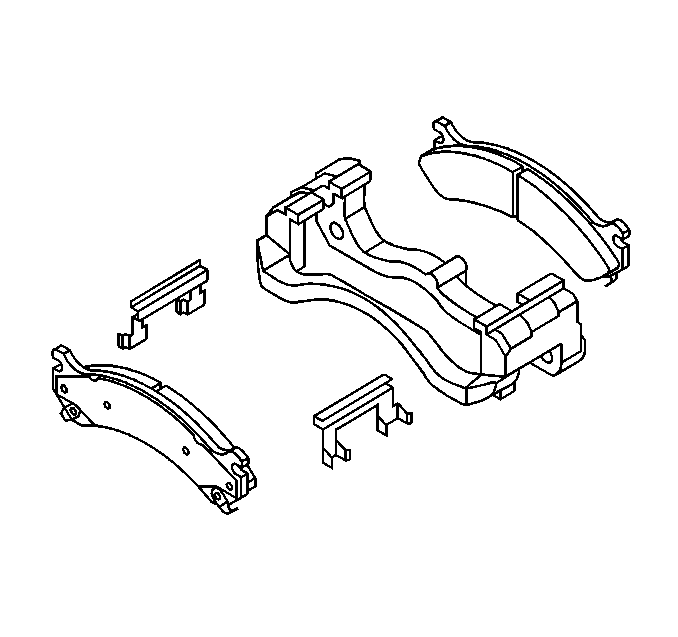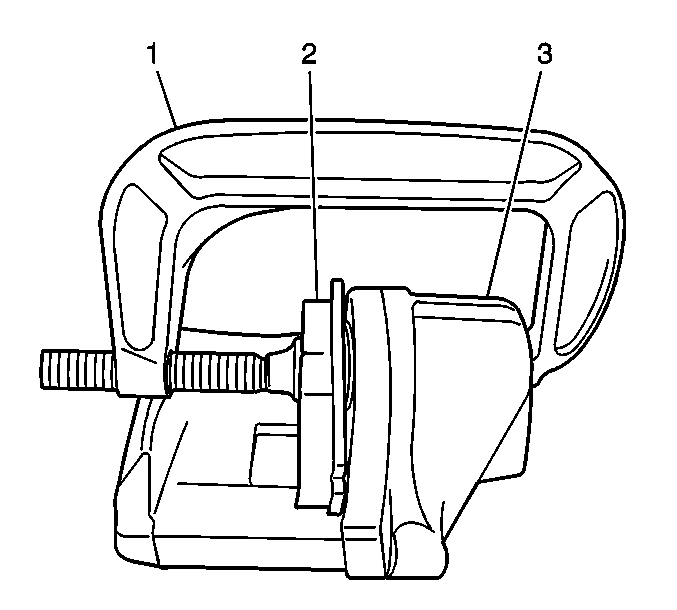Removal Procedure

- Inspect the fluid level
in the brake master cylinder reservoir.
- If the brake fluid level is midway between the maximum--full
point and the minimum allowable level, no brake fluid needs to be removed
from the reservoir before proceeding.
- If the brake fluid level is higher than midway between the maximum-full
point and the minimum allowable level, remove brake fluid to the midway point
before proceeding.
- Raise and support the vehicle. Refer to in
Lifting and Jacking the Vehicle
General Information.
- Remove the tire and wheel assembly. Refer to in
Tire and Wheel Removal and Installation
Tires and Wheels.
- Compress the front caliper piston.
| 6.1. | Install a large C-clamp over the top of the caliper housing and
against the back of the outboard pad. |
| 6.2. | Slowly tighten the C-clamp until the piston pushes into the caliper
bore enough to slide the caliper off the rotor. |
| 6.3. | Remove the C-clamp from the caliper. |
Notice: Support the brake caliper with heavy mechanic wire, or equivalent,
whenever it is separated from its mount and the hydraulic flexible brake hose is still connected. Failure to support the caliper in this manner will cause the flexible brake hose to bear the weight of the caliper, which may cause damage to the brake hose and
in turn may cause a brake fluid leak.
- Remove the caliper from the mounting bracket and support the caliper
with heavy mechanic's wire or equivalent. DO NOT disconnect the hydraulic
brake flexible hose from the caliper. Refer to
Front Brake Caliper Replacement
.
- Remove the brake pads from the caliper mounting bracket.
- Remove and discard the anti-rattle clips from the brake caliper
mounting bracket.
- Inspect the folowing parts for cuts, tears, or deterioration.
Replace any damaged parts:
- Inspect the caliper bolts for corrosion or damage. Do not attempt
to polish away any corrosion. If corrosion is found, use new parts, including
bushings, when installing the caliper.
Installation Procedure

- Using a C-clamp, bottom the piston into
the caliper bore. Use an old brake pad or wooden block placed across the face
of the piston. Do not damage the piston or the caliper boot.

- Install new anti-rattle
clips to the inside ends of the caliper mounting bracket.
- Apply high temperature silicone brake lubricant to the brake caliper
pin bolts and retainers. DO NOT apply lubricant to the brake pad hardware.
- Install the brake pads to the caliper mounting bracket.
| • | Install the inner pad (1 wear indicator). |
| • | Install the outer pad (2 wear indicators). |
- Install the brake caliper. Refer to
Front Brake Caliper Replacement
.
- Install the tire and wheel assembly. Refer to
Tire and Wheel Removal and Installation
in Tires and Wheels.
- Lower the vehicle.
- With the engine OFF, gradually apply the brake pedal to approximately
2/3 of it's travel distance.
- Slowly release the brake pedal.
- Wait 15 seconds, then repeat steps 8-9 until a firm pedal
is obtained. This will properly seat the brake caliper pistons and brake pads.
- Fill the brake master cylinder to the proper level. Refer to
Master Cylinder Reservoir Filling
in Hydraulic
Brakes.
- Burnish the brake pads and rotors. Refer to
Brake Pad and Rotor Burnishing
.



